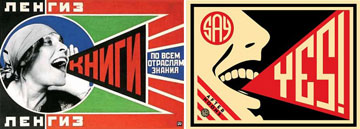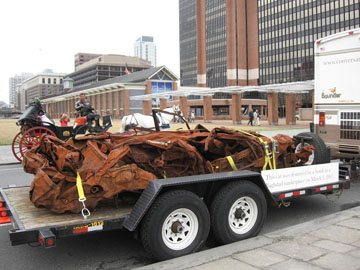
Everything old is new again, (left) a Soviet-era poster by Alexander Rodchenko, and (right) a contemporary poster by Shepard Fairey
These last two months have proved to be full of lively posts about the sometimes clear and often nebulous intersection of Art+Politics.
Art21’s own Marc Mayer kicked things off when he asked:
Is art inherently political, regardless of its intentions or motives? What role has political art played both in the history of art but also in the broader context of history? Can and will art participate in this new mandate of “change,” and if so, how?
His provocative questions allowed for a whole slew of people to chime in with their thoughts about a topic that never gets old.
As expected, there was a lot of talk about Obama (1, 2, 3, 4) and Shepard Fairey in particular, since the latter’s iconic image of the former sparked a global debate about the recent marriage of art and politics in a modern democracy.
Jenny Holzer (Season 4) was a hot topic since her retrospective PROTECT PROTECT traveled from Chicago to New York during the series. Posts focused on many aspects of Holzer’s work, but most poignantly on her deconstruction of a Pentagon PowerPoint presentation that proceeded the 2003 Iraq invasion and hand prints of U.S. soldiers accused of war crimes.
There were also enlightening discussions about:
- the use of art in the classroom during the 2008 election;
- arts programming for incarcerated girls (pt. 1, pt. 2);
- how an artist not traditionally associated with politics—Jessica Stockholder—uses beauty and taste to address political issues;
- a British perspective on art + politics in America;
- an arts group, W.A.G.E. (Working Artists and the Greater Economy), which has been advocating for collective action by arts workers;
- two perspectives from artists working in Oakland, CA;
- a blogger’s look at the “Extimasies: Art, Politics, Society in Times of Crisis” conference in Athens, Greece;
- another blogger points out “a few of the artists who exemplify the shift from an inward to an outward focus” which, she says, is part of the dawn of the new Obama era;
- one writer uses Peter Weiss’ Marat/Sade as a springboard to discuss the character of art in the political arena;
- a sneak peak at the politics of this summer’s La Biennale de Venezia;
- guest blogger Paul Schmelzer asks: Where’s All the Right-Wing Street Artists?;
- three activist artists to watch; and
- a discussion about what Obama should do with the arts and a post lauding the $50 million in arts funding in the stimulus bill that was approved by Congress…

A view of the bombed car part of Jeremy Deller's "It Is What It Is" in Philadelphia. (via the artblog)
…which brings us to our next Flash Points topic, Art+Economics.
But before we closed out this current topic, let’s take a quick look at some other noteworthy news or opinions from around the web on the always relevant and controversial topic of Art+Politics:
- The Abu Ghraib JPEGs, museums and national responsibility (Modern Art Notes);
- A Chinese art dealer whose winning bid of $40 million snagged him two 18th C. Chinese bronzes from the Yves St-Laurent estate is now regretting his foray into international politics (Bloomberg);
- A writer asks “Can Art Impact Politics?” and discusses the archetypal political painting, Pablo Picasso’s Guernica (The Oregonian);
- Another blog looks at the lasting power of Guernica (Art Threat);
- Is art being used to heal the rift between Cuba and the United States? (BBC);
- A New York art dealer thinks about how the humanities can save America (Edward Winkleman):
- Governor Bobby Jindal of Louisiana cuts state funding for the arts 83% (Culture Monster/LA Times);
- A look at the Annual Arts Advocacy day on Capitol Hill (Looking Around/Time); and
- Jeremy Deller’s It Is What It Is: Conversations About Iraq is spotted in Philadelphia (the artblog).
Next up: Art+Economics




Pingback: Reader: April 1, 2009 « updownacross